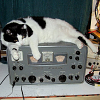Hello, everyone!
I am new here, on this forum and I need some help. Here is the story.
I have come across a number of old aluminum can capacitors rated between 20-170 uF at 200-500V. Some of them were salvaged from old equipment, some of them are NOS. I have checked them for leakage using a Heathkit IT-11, which does not function very well and is not very reliable. I trashed some of the caps, but I also kept about 20 of them that checked OK. I am now trying to reform them using one of those simple circuits found on the web with a few mods. I added a milliampermeter in series with the capacitor and a voltmeter across it. Therefore, when I charge the capacitors I can measure the current through them at different voltage values. I am getting currents between 40-500 uA, depending of the capacitor value and the test voltage.
Here comes the BIG QUESTION!!!
Could any of you, please, give me an idea what the allowable current through these old reformed capacitors might be? By “allowable current” I mean something like how far can I go before the caps don’t filter well and I get hum in my tube circuits. Of course, I could do it by trial and error, but it would be nice to know ahead of time what I should expect.
Thank you in advance for you input.
Electrolytic capacitors reforming
11 posts
• Page 1 of 1
You are on target. Shoot for 500uA and less at max rated voltage (maybe even 5% higher). If it stays higher than that after reforming, chuck them in the trash. So a 500V rated cap would be dissipating 0.25W from DC leakage current. I've let them reform overnight, but usually a few hours does 95% of the job. Also, on multicaps with the same voltage rating, I always tie all the caps together.
Shannon
Shannon
-

Shannon Parks - Site Admin
- Posts: 3764
- Joined: Tue Mar 18, 2003 5:40 pm
- Location: Poulsbo, Washington
Thank you Shannon.
500 uA sounds like a good guideline. I have also tied together the sections rated at the same voltage. Howevwr, I have reformed them for only acouple of hours. I guess I'm a little impatient. I will "cook" them again overnight.
Thanks again.
500 uA sounds like a good guideline. I have also tied together the sections rated at the same voltage. Howevwr, I have reformed them for only acouple of hours. I guess I'm a little impatient. I will "cook" them again overnight.
Thanks again.
- aandre2200
- Posts: 4
- Joined: Fri Aug 17, 2012 11:06 am
Hi, Doug.
You make a good point. I am reforming the old caps as anexperiment. Also, if they turn out OK, I want to use them in some old tube gear. The high voltage caps (350-450V) cost a bit of money, especially if you need many of them. If the reformed ones fail to do job, I can still go to new ones.
Thanks for your input.
You make a good point. I am reforming the old caps as anexperiment. Also, if they turn out OK, I want to use them in some old tube gear. The high voltage caps (350-450V) cost a bit of money, especially if you need many of them. If the reformed ones fail to do job, I can still go to new ones.
Thanks for your input.
- aandre2200
- Posts: 4
- Joined: Fri Aug 17, 2012 11:06 am
I would gut the insides out of the caps and install some new caps inside the aluminum shell. This gives you the look of the aluminum can and the safety of having new caps inside that will not short out on you.
Been there done the reforming thing and that is why I highly recommend just using the shell.
Been there done the reforming thing and that is why I highly recommend just using the shell.
- burnedfingers
- KT88
- Posts: 640
- Joined: Mon Sep 05, 2005 6:38 am
There's a tube reforming unit described in Glass Audio, Vol 9 No 6 (1997).
There're a lot of info and I cannot really extract all that is useful, but a few hints:
The supply is switchable 260/460V. R(series) are 1K, 5K and 12K. There are talks about time constant t=RC (from zero to 62% full voltage) and that a cap would be fully charged efter 5 time constants.
Any charging current below 5mA means cap failure.
I'd simply hook up acapacitor with a resistor, big enough to have the capacitor to charge to full voltage in 5-10 minutes.
And remember to never have the cap to run on full voltage, but just 85-90%. Meaning, a rating of 400V means, runt the cap on maximum 350-360V.
There're a lot of info and I cannot really extract all that is useful, but a few hints:
The supply is switchable 260/460V. R(series) are 1K, 5K and 12K. There are talks about time constant t=RC (from zero to 62% full voltage) and that a cap would be fully charged efter 5 time constants.
Any charging current below 5mA means cap failure.
I'd simply hook up acapacitor with a resistor, big enough to have the capacitor to charge to full voltage in 5-10 minutes.
And remember to never have the cap to run on full voltage, but just 85-90%. Meaning, a rating of 400V means, runt the cap on maximum 350-360V.
Magnus
"It is always more difficult to fight against faith than against knowledge."
"It is always more difficult to fight against faith than against knowledge."
-

soundbrigade - KT88
- Posts: 1760
- Joined: Mon Jan 28, 2008 4:57 am
- Location: Little Paris, Sweden
soundbrigade wrote:I'd simply hook up acapacitor with a resistor, big enough to have the capacitor to charge to full voltage in 5-10 minutes.
That's always worked for me

-= Gregg =-
Fine wine comes in glass bottles, not plastic sacks. Therefore the finer electrons are also found in glass bottles.
Fine wine comes in glass bottles, not plastic sacks. Therefore the finer electrons are also found in glass bottles.
-

Geek - KT88
- Posts: 3585
- Joined: Sun Oct 21, 2007 3:01 am
- Location: Chilliwack, British Columbia
A "big enuff" resistor can be calculated by using the t-formula. A value of some houndred or million Ohms is normally suitable.
Magnus
"It is always more difficult to fight against faith than against knowledge."
"It is always more difficult to fight against faith than against knowledge."
-

soundbrigade - KT88
- Posts: 1760
- Joined: Mon Jan 28, 2008 4:57 am
- Location: Little Paris, Sweden
Depending on the size of the cap, I use 100K, 470K or 1Meg.
No need to be critical. It just has to slowly ramp up charge.
To discharge, use a 100 ohm, 10 watt resistor.
No need to be critical. It just has to slowly ramp up charge.
To discharge, use a 100 ohm, 10 watt resistor.
-= Gregg =-
Fine wine comes in glass bottles, not plastic sacks. Therefore the finer electrons are also found in glass bottles.
Fine wine comes in glass bottles, not plastic sacks. Therefore the finer electrons are also found in glass bottles.
-

Geek - KT88
- Posts: 3585
- Joined: Sun Oct 21, 2007 3:01 am
- Location: Chilliwack, British Columbia
Thank you all for your suggestions and advice. I have now all the information I need and I should be able to resurect some of these capacitors.
Thank you again.
Thank you again.
- aandre2200
- Posts: 4
- Joined: Fri Aug 17, 2012 11:06 am
11 posts
• Page 1 of 1
Who is online
Users browsing this forum: No registered users and 33 guests
